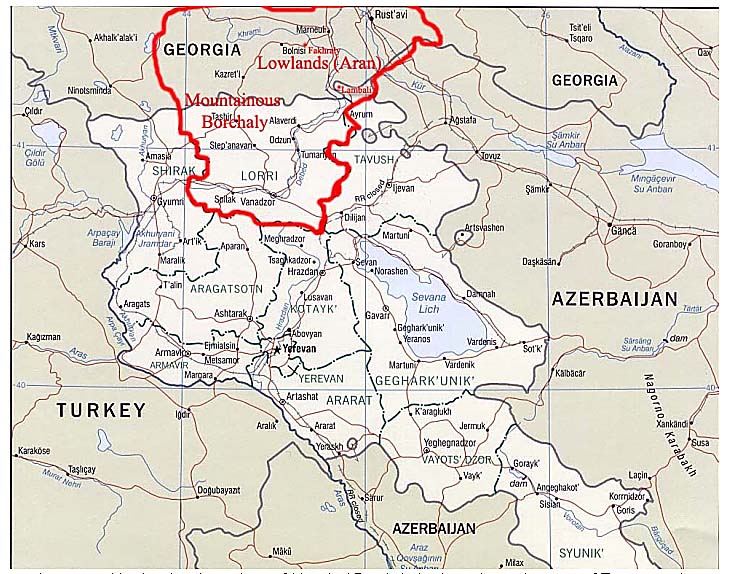
A map roughly showing the territory of historical Borchaly lands on the modern map of Transcaucasia.
General Information: Antique rugs with this design were
woven in historical Borchaly Region – the center can be shown as the Lambali (so called Lambalo)-Fakhrali (so called Fachralo)
district. Most of the survived examples are from Lambali village of Loru Region (Mountainous Borchaly).
Geographical Distribution: As it is mentioned above, this type
of Borchaly / Lori Pambak rugs were woven mainly in Lowland (called as Aran in
Azeri) villages of Borchaly region. It starts from Fakhraly village in the north
to Lambali and its vicinity on the border of today’s Georgia and Armenia.
Note: There are two Lambali villages in historical Borchaly lands. The one is in Qarayazi district (today in Georgia - and the name is changed into Lambalo). The second one is in the historical Loru/Lori Region and falls into the territory of today’s Armenian Republic. Today, the name of the village changed into Debedashen (in Armenian). "Lambalo" labeled antique Loru Pambak rugs were woven exactly in this village, not in the Lambali of Qarayazi Region. The population of both villages was Karapapakh Turks until 1988.
 A map roughly showing the territory of historical Borchaly lands on the modern map of Transcaucasia. |
|
Between the 8th-15th centuries the area was a part of Umayyad and Abbasid Caliphates, Seljuque Turks, Akkoyunlu and Karakoyunlu (Turkic Oghuz confederation of tribes) States.
Between the 16th – 18th centuries, Borchaly was a part of Ganja Province (Beylerbeylik) of Safevid Empire. In 1736, when the coronation of Nadir Shah took place in Mughan, where the Turkmen (Azeri) military and tribal aristocracy gathered, the khan of Ganja Province ((belonged to Ziyadoglu branch of Turkic Gajar Tribe) didn't participate in there for some reasons. This event led Nadir shah to cede the territory of Borchali Sultane to the Georgian kingdom of Kartli Kakheti (Loru Pambak was a southern part of the historical Borchaly Sultanate).
The area was occupied by Russian Empire in the beginning of
the 19th century. Later, Lori was occupied by Armenian Military Forces in 1918 (it was a part of Georgia then).
Note: Important part of the Loru Pambak Region was known as “Dagh Borchalysy” between the local Karapapakh Turks, which means mountainous Borchaly. |
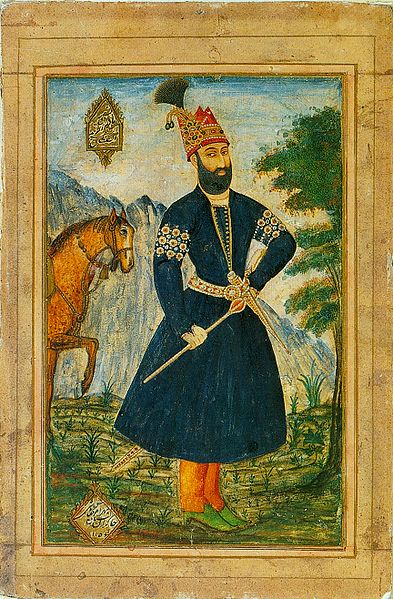 Bahram. Portrait of Nadir Shah Afshar. 1743-44. Hermitage. Saint Petersburg. |

A map showing the historical provinces of western Trans-Caucasia.
Ethnic Composition of the Region: The main population of
Lowland Borchaly and Mountainous Borchaly (as well as Loru Pambak Area) was
Karapapakh Turks until the 20th century. Lambali village was 100% inhabited by
Karapapakh Turks, who wove most of the antique Lori Pambak rugs. There are historical
Karapapakh gravestones in the Lambali
village dating back to the 16th century.
Lambali means "a place with a lamp" in
Azeri. Lambalo is a georgianized version of Lambali.
There are some half million Turks in Georgia, which 300 000 of them live in Borchaly Region.
Lori Pambak Region: The population was roughly 90 percent
Muslim (mainly Azeri Turks and Kurds) and 10 percent Christian (Armenian) in the
first quarter of the 19th century. Until 1988, Azeri Turks were still a large
part of the population.
The Azeri Turkic community in these lands has been virtually
non-existent since 1988–1991, when the overwhelming majority of Azeris were
expelled out of the country by Armenians as a result of Karabagh conflict.
Here is another map that I indicated the location of the Mountainous and Lowland Borchali for a better understanding.
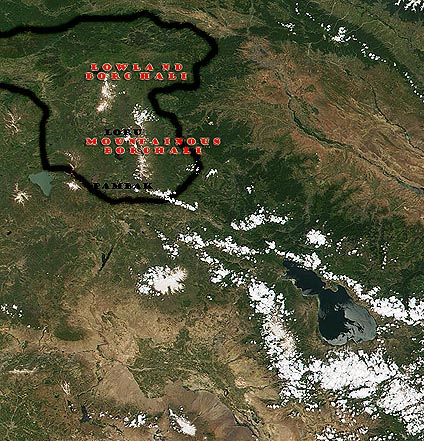
Lambali Frog design rugs / Analysis of the design
Few antique Lori Pambak rugs with this specific design are known. The Lori Pambak rugs with this design are highly priced because they are thought to be early. Here are some of the published examples of this type:
1) Charles W. Jacobsen, Oriental Rugs, pi. 152 (. An example illustrated by Raoul Tschebull, "The Development of Four Kazak Designs", Hali, vol. 1, no. 3, seems to be the same piece as that illustrated by Jacobsen)
2) Peter Bausback, Antike Orienlteppiche, p. 159
3) The one sold at Nagel's Big Senmurv Auction, Munich, Germany in 1993
4) The Lori Pambak rug published at Ian Bennett’s Oriental Rugs Volume I, plate no:4
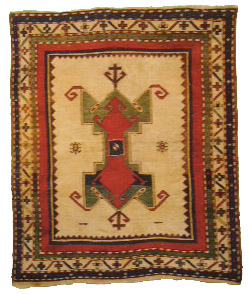
Peter Bausback, Antike Orienteppiche, p. 159

A Lambali prayer rug with natural ivory field and borders. This is the only known antique Lambali /Lori Pambak rug with Frog / Cow / Sheep Skin design which is in a prayer rug format. Others have almost identical colour arrangements and have square white fields. 141 x 110 cm. Ian Bennett’s Oriental Rugs Volume I, plate no:4
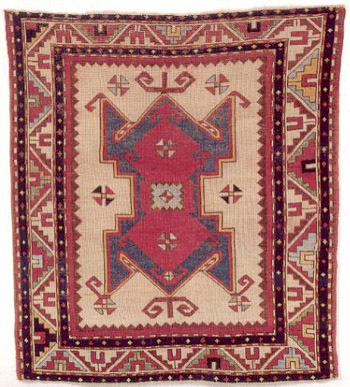
The white ground Kazak Loru Pambak, Lot 96, 127x109cm, sold DM 15,000. Nagel's Big Senmurv Auction, Munich, Germany, 1993
The following rug is from Ulrich Schurmann's "Caucasian Rugs". 1974,
Washington International Associates. Let's see how he describes the design:
"At first I called it "a cow with eight feet". The head up the top and the eight legs following behind. I imagine that a cow somewhere in the South Caucasus had a miscarriage and the fetus had eight legs and the event was so extraordinary that they wove it into a carpet. It could also be an insect, with eight legs and the "antlers" at the top. But I don't think so... This piece was hanging in the first floor window of a gallery on Madison Avenue - you could see it from the street. When I came in June, I tried to buy it, but it was so expensive that I didn't. When I returned, in November, to my amazement it was still there! And I bought it. This was 1960 or so..."
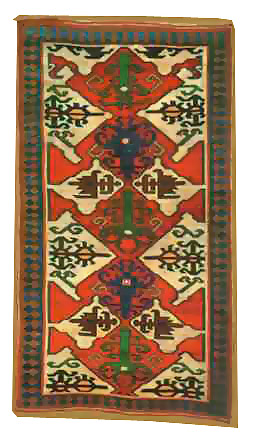
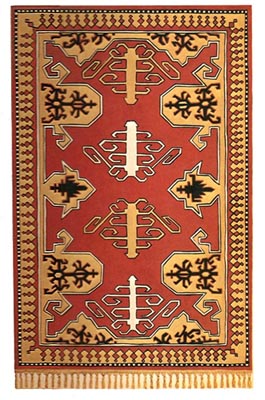
A Lori Pambak rug from "Ulrich
Schurmann's "Caucasian Rugs" and a rug with similar design from L. Kerimov's
"Azerbaijan Rugs" (it looks like a sketch to me)
What I think is the large
medallion in the central field is not anything else but the continuous frog
motifs arranged from top to the bottom.
The other well-known designs of Loru Area of Borchaly Region are:
a) "Kilseli" (Zeynetnishan) design -
This design was used in Kizil Kilse, Kizil Hajili, Gavurarkh, Qushchular,
Jujalar, Deliler, Yirghanchay villages. The design is erroneously called as "Kazak Sewan" in
western literature.
b) Zigzag design was woven mainly in Sadakhly and Sarvan villages.
c) Karachop design was woven in Karachop village of Loru Region (not in today's
Karachop - which is in Georgia now)
d) Many "Lori Pambak" labeled rugs were woven in Lambali village. The main
element on this design is a "Frog" medallion in the central field.
e) Life Tree design rugs were woven mainly in Qochulu village (today is in
Georgia) and partly in Tovuz Area (Kazak) All these villages were inhabited by
Turks, to be more specific by Karapapakh Turks. In Georgia, these villages are
still inhabited by Turks.
Origin of the design
There are different opinions about the origin of the design.
1) The distinctive quatrefoil medallion is believed to be derived from an early animal totemic symbol representing pairs of animals and birds.
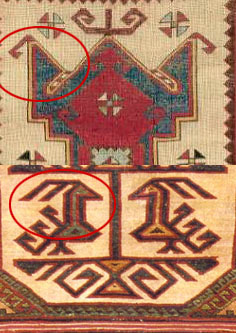
(bottom) The early fifteenth century Caucasian rug with
conventionalised animal-forms, National Historical Museum, Stockholm. For a full
sized image of this rug, see
here
2) The second opinion says that "the
large archaic medallion in the central field is a stylized frog".
Frog was considered as a totem by ancient Turks and it was endowed with
the ability to summon rain and the rebirth of nature. Baka tuyme / Frog
motif was abundantly used by Karakalpak Turks as the totemic symbol of fertility
(during the process
of its artistic evolution, it turned into a symbol of the life tree (and came to
resemble the leaf of a tree) having absorbed the ideas of a cult connected with
the agricultural culture.)
The ancient Turkic people made a connection between frog and water - to symbolize purity and happiness. Shamans who were intermediaries between the natural and spiritual world and who could travel between worlds in a state of trance, noticed that frogs could make the quick and effortless leap from one stage of consciousness to another, thus they were a symbol of magic to them.
There is a saying in Borchali: "Frog is a fish in
water and a nightingale outside"
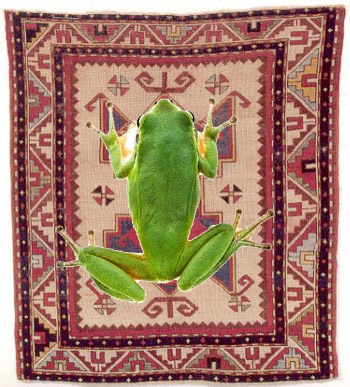
3) There is also an opinion that the central medallion represents a "dragon" or
a "sheep skin".
Border. The Bausback rug has a stylzed cross motif border and one of the samples carry a zig-zag pattern central border motif (?), other pieces have versions of the leaf-and-calyx border.